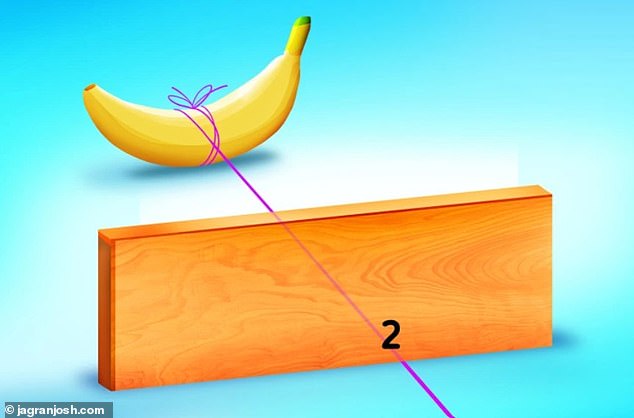Only people with a high IQ can solve this banana brain teaser in 7 seconds
A new brain teaser claims that only people with high IQs can solve the puzzle in seven seconds.
The goal is to determine which wire on the right side of the board leads to the wire attached to the banana.
It is important to look at the image carefully rather than making a predetermined choice between four possible strings.
These types of puzzles can tell you a lot about how you think and see the world, and can help you develop problem-solving and logical reasoning skills.
Only people with a high IQ can figure out which wire is attached to the banana
The image shows a string wrapped around a banana and running to a wooden board with four strings labeled ‘1, 2, 3, 4’ on the other end.
This answer may not be as simple as you think, as many people think the third string is the correct answer, thus Jagran Josh who created the optical illusion.
This is because the brain doesn’t look at the image as a whole, but instead uses shortcuts and skips parts so you can process the information faster.
It looks for the most basic information to identify what you are looking at, and to guess what the full image is if it is not complete.
In 2011, researchers at the University of Glasgow discovered that when something is unclear to the naked eye, the brain predicts what it will see and fills in the missing information itself.
‘Effectively, our brains are building an incredibly complex jigsaw puzzle using whatever pieces they can find,’ explained researcher Fraser Smith.
So if you look closely at the rope options and draw a line between the banana and the plate, you will see that the second rope leads to the fruit.

Although most people choose the third string, the correct option is string number two
Because we live in a three-dimensional world, optical illusions can fool you because your brain doesn’t get the same cues like depth, shadow, lighting and position to help interpret what you see as it does in your everyday life, according to the National Eye Institute.
A 2021 study Research has shown that the ‘logical stress and limit stress that arise during brain-teaser play are positive stresses, with a desirable effect on the players’ attention.’
“These two types of stress improve cognitive skills such as attention, concentration and problem solving by activating the frontal lobe of the brain,” the study found.
Other studies have shown that brain teasers play a significant role in improving memory and attention span, improving problem-solving skills, preventing cognitive decline, and increasing a person’s mental agility, or the ability to process information quickly.
These types of optical illusions are great tools if you want to promote brain stimulation and can help develop visual and spatial reasoning skills.
According to the National Institute of Health, the puzzle can be used to “improve the function of the prefrontal cortex, which plays an important role in cognitive skills such as thinking, decision-making, concentration, and problem solving.”
“It’s really important to realize that we’re not seeing reality,” neuroscientist Patrick Cavanagh, a research professor at Dartmouth College, told Vox in 2020.
“We see a story being created for us.”
